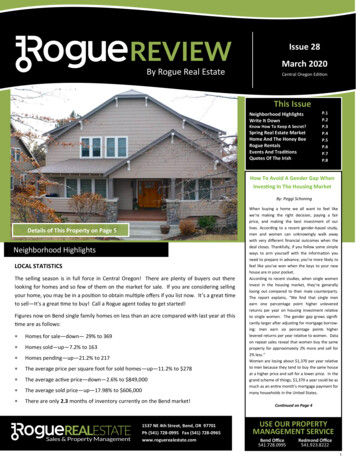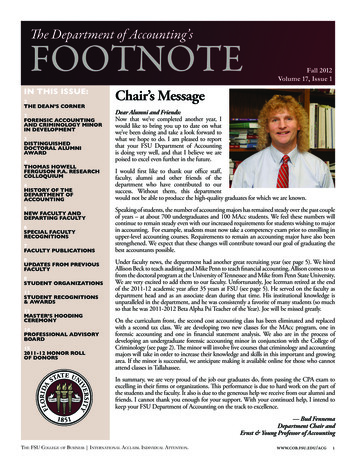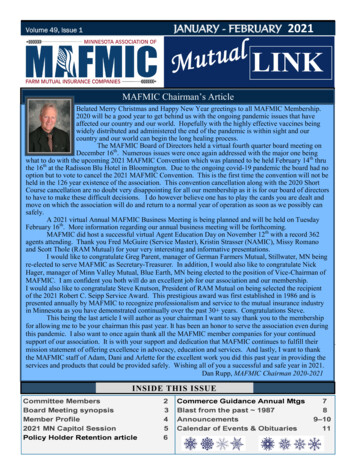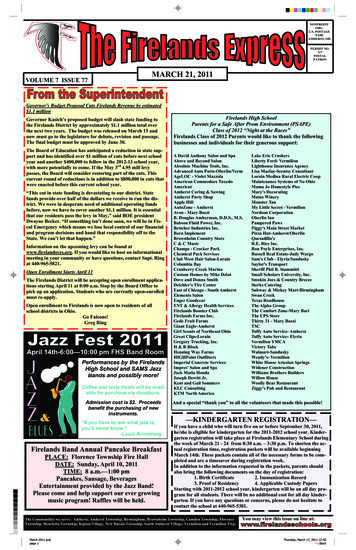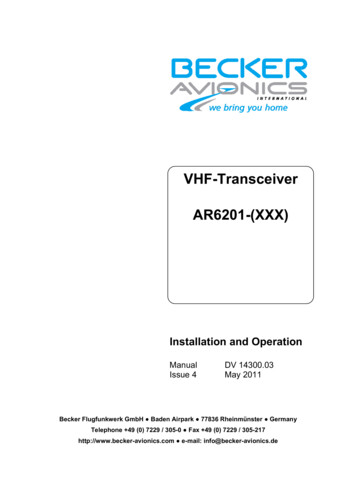
Transcription
VHF-TransceiverAR6201-(XXX)Installation and OperationManualIssue 4DV 14300.03May 2011Becker Flugfunkwerk GmbH Baden Airpark 77836 Rheinmünster GermanyTelephone 49 (0) 7229 / 305-0 Fax 49 (0) 7229 / 305-217http://www.becker-avionics.com e-mail: info@becker-avionics.de
FIRST ISSUE AND CHANGESIssue 1 May 2010Issue 2 October 2010Issue 3 March 2011Issue 4 May 2011LIST OF EFFECTIVE PAGESPage No.:Date:Cover Page5/20111-I 1-II1-1 1-105/20115/20112-I 2-II2-1 2-305/20115/20113-I 3-II3-1 3-135/20115/2011Page No.:DV 14300.03 / Article Number 0617.857-071 2011 by Becker Flugfunkwerk GmbH / All rights reservedDate:
AR6201Table of .6.41.6.51.6.61.6.71.6.81.6.91.71.8DV 14300.03/.04 Issue 4 5/2011GENERAL DESCRIPTIONIntroductionPurpose of EquipmentGeneral NotesShort DescriptionVariants SurveyTechnical DataPower Supply DataGeneral DataDimensions & WeightReceiver DataTransmitter DataEmergency OperationSoftwareComplex HardwareRegulatory ComplianceEnvironmental QualificationAccessoriesPage11124444556666778Page 1-I
AR6201BlankPage 1-IIDV 14300.03/.04 Issue 4 5/2011
AR6201Section 11.1GENERALIntroductionThis manual describes the VHF transceiver AR6201-(XXX). The manuals DV 14300.03(“Installation and Operation”) and DV 14300.04 (“Maintenance and Repair”) contain the followingsections.SectionDV 14300.03DV ry of operationN/AX5Maintenance and RepairN/AX6Illustrated Parts ListN/AX7Modification and ChangesN/AX8Circuit DiagramsN/AX1.2Purpose of EquipmentThe AR6201-(0XX) VHF transceiver enables voice communication in the very high frequency bandbetween 118.000 MHz and 136.9916 MHz with a selectable channel spacing of 25 kHz or 8.33kHz.The AR6201-(1XX) VHF transceiver enables voice communication in the very high frequency bandbetween 118.000 MHz and 136.9750 MHz with a selectable channel spacing of 25 kHz only.1.3General NotesThe word “frequency” in this document is also used in the sense of “channel name” as defined inEUROCAE, ED-23B, chapter 1.3.2.The word “memory channel” or “channel” used in this document means a memory place identifiedby a channel number. On that memory place a frequency may be stored for later use.DV 14300.03/.04 Issue 4 5/2011Page 1-1
AR62011.4Short DescriptionThe VHF transceiver is designed as a single block unit for usage in cockpit environment of generalaviation aircrafts including helicopters.The VHF transceiver is a compact and lightweight single block unit. The dimensions correspond tothe standard instrument diameter of 58 mm (2 ¼ inch). Mounting is by means of four screws (rearpanel installation). All controls and indicators are located on the front panel. The equipmentconnectors and the antenna socket are located at the rear of the unit.Frequency IndicationThe frequency indication is done by means of a liquid crystal display (LCD). The required operatingfrequency is set with the rotary knob. The relation between the real operating frequency and thedisplayed frequency is according to standards (ED-23B, chapter 1.3.2). For overview refer tablebelow.Operating Frequency(MHz)Channel Spacing(kHz)Displayed Frequencyin 25 kHz Mode25Displayed Frequencyin 8.33 25 kHzmixed .33136.990N/A118.00Audio OutputsThe transceiver includes two audio outputs: Headphone and Speaker. The Headphone ratedoutput power is 300 mW into 150 Ohm. The rated output power from the Speaker Output is 4 Winto 4 Ohm.Mike InputsThe VHF transceiver has an input for dynamic microphone (DYN MIKE) and an input for standardmicrophone (STD MIKE). Each input is able to operate with single microphone or with 2microphones of the same type connected in parallel.AF Auxiliary InputThe AF auxiliary input enables to connect an external audio source (NAV, music-player ) to thetransceiver. The external audio will be audible only when transceiver is in receive operation.Page 1-2DV 14300.03/.04 Issue 4 5/2011
AR6201SidetoneThe sidetone is available on the headphone output during transmission. The sidetone volume iscoupled with the Intercom Volume.Squelch OperationThere are two kinds of squelch methods implemented, carrier squelch and noise squelch. Thecarrier squelch is based on received signal strength and adjustable in installation setup; the noisesquelch is based on detected noise level and adjustable in pilot setup.Memory ChannelsThe VHF transceiver also contains a channel memory device for automatically/manually storage of99 frequencies. The last 9 used (active) frequencies are always stored automatically. In addition amanual storage of up to 90 different frequencies is possible.Intercom OperationAircraft internal communication via connected headsets is possible due to the internal built inintercom. Intercom operation may be triggered automatically via VOX (adjustable) or externally viaintercom switch. Setting of VOX-threshold and Intercom Volume is accessible by pilot in theintercom menu.Scan ModeIn scan mode (also called dual watch function) the device is capable to monitor two frequencies(active & preset) at the same time.IlluminationThe illumination of LCD and push buttons can be controlled either internally from the front panelknob or externally via the dimming inputs. In case of external dimming the illumination curve(brightness to voltage relation) can be adjusted in the installation setup.LOW BATT IndicationThe VHF transceiver also contains a monitoring stage for the power supply voltage. If the supplyvoltage drops below the adjustable threshold, the display indicates the message “LOW BATT”. Thefactory setting for that adjustable threshold is 10.5 V.Emergency OperationIn emergency operation (from 9.0 to 10.25 V) the performance of the device is degraded: For TX Mode: RF Rated power is 2 W @ 50 Ohm, modulation depth is 50 %, For RX Mode: (S N)/N 6 dB for RF level -93 dBm, m 30%, 1 kHz sine Panel Backlight is switched off Speaker output is switched off. Only the headphone output is still operating.CAUTION:For power supply voltages below 10 V the speaker output of the transceiver isautomatically switched off, without dedicated notification of the user. !Depending on settings of installation setup “LOW BATT” may be indicated if supply voltage dropsbelow predefined threshold.If this threshold is adjusted in range 10.3 10.5V this “LOW BATT” warning may also indicate tothe user, that he should connect his headset (because speaker may be switched off soon).Built In TestsAfter switch on, the unit performs a self test (PBIT). During PBIT the transceiver shows “WAIT” andthe corresponding software versions of the control head and chassis module. During normaloperation a continuous built in test (CBIT) verifies the correct operation of the unit in background. Incase of problems a warning or failure message will be displayed.DV 14300.03/.04 Issue 4 5/2011Page 1-3
AR6201Installation SetupConfiguration of the installation parameters like mike sensitivity, mike type selection, speakerenable/disable and further parameters is possible via Installation Setup.Service ModeSpecial factory configuration of the system is possible in Service Mode via a RS422 interface with aproprietary serial data communication protocol.1.5Variants SurveyPart NumberArticle NumberPanel ColorDisplay Color25 kHz ModeAR6201-(000)0610.321-910blackgreenYes8.33 25 kHzmixed ModeYesAR6201-(002)0614.203-910blackblue - t availableAR6201-(102)0621.226-910blackblue - whiteYesNot available1.6Technical Data1.6.1Power Supply DataNominal supply voltage rangeAbnormal supply voltage range11.0 30.3 V DC10.25 V 32.2V DCEmergency operationrefer chapter 1.6.6)9.0 V DC 10.25 V DC (degraded performance,Power consumptionPower off stateReception modeTransmission mode 1.5 mA @ 12 V DC 140 mA @ 14 V DC, panel backlight off 2A@ 14 V DC, 70 % modulated, VSWR 1:1 4A@ 14 V DC; 70 % modulated, VSWR 3:1DC-Fuse internal5 A (resetable)Dimming control14 V DC or 28 V DC1.6.2General DataFrequency rangeFrequency range *118.000 MHz to 136.975 MHz (25 kHz mode)118.000 MHz to 136.9916 MHz (8.33 25 kHz mode)Channel spacing25 kHz or 8.33 kHzNumber of channels760(25 kHz mode)2280 760 (8.33 25 kHz mixed mode)Storage temperature range-55 C to 85 CPage 1-4DV 14300.03/.04 Issue 4 5/2011
AR6201Operating temperature range as perEUROCAE/RTCA ED-14E/DO-160E-20 C to 55 Cshort-time 70 COperating altitude as perEUROCAE/RTCA ED-14E/DO-160E35,000 ftVibration as perEUROCAE/RTCA ED-14E/DO-160ECategory S (Curve M) Category U (Curve G)1.6.3Dimensions & WeightFront panel61.2 mm x 61.2 mmDepth of unit211.4 mm (front plate till end of antenna connector)Mounting (backpanel)standard 58 mm diameter (21/4 inch)Material of CaseALMgSurface treatmentcontrol head coated with black matt paintWeight850 g1.6.4Receiver DataSensitivity -101 dBm for a (S N)/N ratio of 6 dB (nominal) -93 dBm for a (S N)/N ratio of 6 dB(qualified under environmental conditions)Effective bandwidth *(8.33 kHz channel) 2.78 kHz at the 6 dB points 7.37 kHz at the 60 dB pointsEffective bandwidth(25 kHz channel) 8 kHz at the 6 dB points 22 kHz at the 60 dB pointsSquelchtrigger level adjustableAGC characteristic 6 dB in range -93 dBm to 0 dBmDistortion m 85% 15%Audio frequency responserelative to 1000 Hz 6 dB 350 Hz to 2500 Hz 35 dB at 4000 HzRated output for speaker operation 4 W into 4 ΩRated output powerfor headphone operation 300 mW into 150 Ω 100 mW into 600 ΩAudio auxiliary input1 V to 8 V (adjustable) across 600 Ω 10%DV 14300.03/.04 Issue 4 5/2011Page 1-5
AR62011.6.5Transmitter DataOutput power 6 W into 50 Ω (with and without modulation)Frequency tolerance 5 ppmDuty cycle1 minute (TX) : 4 minutes (RX)Type of modulationA3E (amplitude modulation)Modulation capability 70%Distortion at 70% modulation 15%Modulation bandwidth: 6 dB, 350 Hz to 2500 HzDynamic microphone(with compressor)1 20 mV compressor starting point, adjustableInput balanced, 200 ΩInput range up to 30 dB above compressor startingpoint.Standard microphone(with compressor)10 1000 mV compressor starting point, adjustableInput unbalanced, 150 ΩInput range up to 30 dB above compressor startingpoint.FM deviation with modulation 3 kHzSidetoneadjustableAutomatic shutdown of transmit mode120 seconds1.6.6Emergency OperationTX Output power 2 W into 50 Ω (with modulation)TX Modulation Depth 50 %RX Sensitivity -93 dBm for a (S N)/N ratio of 6 dBPanel & Display Backlightswitched offSpeaker Outputswitched offHeadphone Outputoperating1.6.7SoftwareNearly all functions inside the transceiver are controlled by microprocessors. The software isclassified as Level D in accordance with EUROCAE/RTCA document ED12B/DO-178B.1.6.8Complex HardwareThe device does not contain complex custom microcoded components.Page 1-6DV 14300.03/.04 Issue 4 5/2011
AR62011.6.9Regulatory CompliancePart NumberArticle NumberEASA 8-9100621.226-910ETSO-2C37eClass: D, ETSO ApprovalFCC ApprovalTSO-C169aClass: D, E, 4, 6B54AR6201TSO-C169aClass: D, 4B54AR6201ETSO-2C38eClass: 4, 6EASA.210.1249ETSO-2C37eClass: DETSO-2C38eClass: 4Note: Unauthorized changes or modifications to the AR6201-() may void the compliance tothe required regulatory agencies and authorization for continued equipment usage.1.7Environmental QualificationThe following performance under environmental test conditions have been established inaccordance with the procedures set forth in EUROCAE/RTCA Document ED-14E/DO-160E.ConditionSectionCat.Temperature and Altitude4.0C4Ground Survival Low Temperature4.5.1Description-55 deg CShort-Time Operating LowTemperature-20 deg COperating Low Temperature-20 deg CHigh Ground Survival Temperature 4.5.2 85 deg CHigh Short-Time Operating Temp.4.5.3 70 deg COperating High Temp.4.5.4 55 deg CIn-flight Loss of Cooling4.5.5XNo forced cooling requiredAltitude4.6.1C435,000 ftDecompression4.6.2Overpressure4.6.3Temperature Variation5.0B5 C per minuteHumidity6.0AStandardShock and Crash Safety7.0BVibration8.0SUFixed-wing and Helicopter,standardCurve M for Fixed-wing AircraftCurve G for HelicoptersExplosion proofness9.0XN/AWater proofness10.0YCondensing waterDV 14300.03/.04 Issue 4 5/2011Page 1-7
AR6201ConditionSectionCat.DescriptionFluids Susceptibility11.0XN/ASand and Dust12.0XN/AFungus Resistance13.0XN/ASalt Spray14.0XN/AMagnetic Effect15.0ZLess than 0.3mPower Input16.0BVoltage Spike17.0AAudio Freq. ConductedSusceptibility18.0BInduced Signal Susceptibility19.0ACRadio Frequency Susceptibility20.0SWEmission of Radio FrequencyEnergy21.0BLightning Induced TransientsSusceptibility22.0A1E3XLightning Direct Effects23.0XN/AIcing24.0XN/AElectrostatic Discharge25.0AEquipment operated in anaerospace environmentFire, Flammability26.0XN/A1.8DC installations with battery ofsignificant capacityHigh degree of protection againstvoltage spikesDC installations with battery ofsignificant capacityPrimary power DC or AC, 400HzInterim High Intensity RadiatedFieldsEquipment where interferenceshould be controlled to atolerable levelPin test waveform A, level 1Cable bundle test waveform E,level 3AccessoriesConnector Kit CK4201-S (soldering version) Article-No.: 0879.304-954consisting of:25-pol. cable connector, soldering FArticle no. 0725.021-277Connector housingArticle no. 0775.479-277Antenna plugArticle no. 0725.706-277Label “COMM”Article no. 0711.111-258Page 1-8DV 14300.03/.04 Issue 4 5/2011
AR6201Connector Kit CK4201-C (crimp version)Article-No.: 0514.901-954consisting of:25-pol. cable connector, crimp FArticle no. 0472.921-277Connector housingArticle no. 0775.479-277Antenna plugArticle no. 0725.706-277Label “COMM”Article no. 0711.111-258
5 Maintenance and Repair N/A X 6 Illustrated Parts List N/A X 7 Modification and Changes N/A X 8 Circuit Diagrams N/A X 1.2 Purpose of Equipment The AR6201-(0XX) VHF transceiver enables voice communication in the very high frequency band between 118.000 MHz and 136.9916 MHz with a selectable channel spacing of 25 kHz or 8.33 kHz. The AR6201-(1XX) VHF transceiver enables voice
